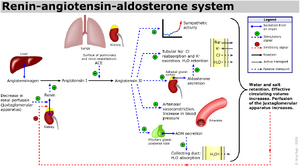Assessment |
Biopsychology |
Comparative |
Cognitive |
Developmental |
Language |
Individual differences |
Personality |
Philosophy |
Social |
Methods |
Statistics |
Clinical |
Educational |
Industrial |
Professional items |
World psychology |
Biological: Behavioural genetics · Evolutionary psychology · Neuroanatomy · Neurochemistry · Neuroendocrinology · Neuroscience · Psychoneuroimmunology · Physiological Psychology · Psychopharmacology (Index, Outline)

Schematic depicting how the RAAS works. Here, activation of the RAAS is initiated by a low perfusion pressure in the juxtaglomerular apparatus
Renal corpuscle. Juxtaglomerular apparatus is "D".
The juxtaglomerular apparatus is a microscopic structure in the kidney, which regulates the function of each nephron. The juxtaglomerular apparatus is named for its proximity to the glomerulus: it is found between the vascular pole of the renal corpuscle and the returning distal convoluted tubule of the same nephron. This location is critical to its function in regulating renal blood flow and glomerular filtration rate. The three cellular components of the apparatus are the macula densa of the distal convoluted tubule, smooth muscle cells of the afferent arteriole and juxtaglomerular cells.
Cells of the Juxtaglomerular Apparatus[]
The juxtaglomerular apparatus consists of: (1) the juxtaglomerular cells, (2) the macula densa, (3) the Lacis cells or agranular cells.[1]
Granular Cells[]
Granular cells are modified pericytes of glomerular arterioles. They are also known as juxtaglomerular cells (juxtaglomerular cells are not granular cells but are granulated as they release renin).
The juxtaglomerular cells secrete renin in response to:
- Beta-1 adrenergic stimulation
- Decrease in renal perfusion pressure (detected directly by the granular cells)
- Decrease in NaCl concentration at the macula densa, often due to a decrease in glomerular filtration rate, resulting in slower filtrate movement through the proximal tubule and thus more time for reabsorption.
Macula Densa Cells[]
Macula densa cells are columnar epithelium thickening of the distal tubule. The macula densa senses any increase in the sodium chloride concentration in the distal tubule of the kidney and secretes a locally active (paracrine) vasopressor which acts on the adjacent afferent arteriole to decrease glomerular filtration rate (GFR), as part of the tubuloglomerular feedback loop.
Specifically, excessive filtration at the glomerulus or inadequate sodium uptake in the proximal tubule / thick ascending loop of Henle brings to the distal convoluted tubule fluid that has an abnormally high concentration of sodium. Apical Na-K-2Cl cotransporters move sodium into the cells of the macula densa. The macula densa cells do not have enough basolateral Na/K ATPases to excrete this added sodium, so the cell's osmolarity increases. Water flows into the cell to bring the osmolarity back down, causing the cell to swell. When the cell swells, a stretch-activated non-selective anion channel is opened on the basolateral surface. ATP escapes through this channel and is subsequently converted to adenosine. Adenosine vasoconstricts the afferent arteriole via A1 receptors and vasodilates (to a lesser degree) efferent arterioles via A2 receptors, which decreases GFR. Also, adenosine inhibits renin release in JG cells via A2 receptors on JG cells using a Gi pathway.
Additionally, when macula densa cells detect higher concentrations of Na and Cl they inhibit nitric oxide synthetase (decreasing renin release) by an unknown pathway.
A decrease in GFR means less solute in the tubular lumen. As the filtrate reaches the macula densa, less NaCl is reabsorbed. The macula densa cells detect lower concentrations of Na and Cl and upregulate nitric oxide synthetase (NOS). NOS creates NO which catalyses the formation of prostaglandins. These prostaglandins diffuse to the granular cells and activate a prostaglandin-specific Gs receptor. This receptor activates adenylate cyclase, which increases levels of cAMP. cAMP augments renin release. Prostaglandins and NO also vasodilate the afferent arterioles. Efferent arterioles are spared from this effect by renin release.
Pathology[]
Elevated renin due to renal artery stenosis or a very rare renin-producing juxtaglomerular cell tumor of the kidney can produce secondary hyperaldosteronism (as apposed to primary hyperaldosteronism aka Conn syndrome, usually due to a functional adrenal adenoma).
Hyperactivity of the renin-angiotensin-aldosterone system is manifested by hypertension with hypervolemia which is severe and not responsive (or minimally responsive) to medications/lifestyle modifications that would usually control essential hypertension. In addition, patients with hyperaldosteronism will have hypernatremia, hypokalemia and metabolic alkalosis.
See also[]
- Kidney
- Renal corpuscle
- Juxtaglomerular cell tumor
- Renin-angiotensin system (RAS)
- Hyperaldosteronism
References[]
- ↑ Robbins and Cotran Pathologic Basis of Disease 7E
External links[]
- Animation of the Juxtaglomerular Apparatus Location, Structure, and Function. (Adobe Flash is required)
- Electron micrograph
- Diagram
| Urinary system - Kidney - edit |
|---|
| Renal capsule | Renal cortex | Renal medulla (Renal sinus, Renal pyramids) | Renal calyx | Renal pelvis |
| Nephron - Renal corpuscle (Glomerulus, Bowman's capsule) → Proximal tubule → Loop of Henle → Distal convoluted tubule → Collecting ducts
Juxtaglomerular apparatus (Macula densa, Juxtaglomerular cells) Renal circulation - Renal artery → Interlobar arteries → Arcuate arteries → Cortical radial arteries → Afferent arterioles → Glomerulus → Efferent arterioles → Vasa recta → Arcuate vein → Renal vein |
| Renal physiology |
| Filtration - Ultrafiltration | Countercurrent exchange
Hormones effecting filtration - Antidiuretic hormone (ADH) | Aldosterone | Atrial natriuretic peptide Endocrine - Renin | Erythropoietin (EPO) | Calcitriol (Active vitamin D) | Prostaglandins |
| Assessing Renal function / Measures of Dialysis |
| Glomerular filtration rate | Creatinine clearance | Renal clearance ratio | Urea reduction ratio | Kt/V | Standardized Kt/V | Hemodialysis product |
| This page uses Creative Commons Licensed content from Wikipedia (view authors). |